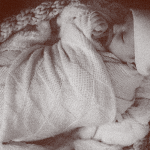The mother-moon bent down and kissed her sleeping child on the forehead. Her lips were hard and cracked and a little spongey, as if a fungus had grown behind the huge bark-like façade of her face and softened its cratered depths. The tide, the tide, she whispered, and blew a thread of sea air into her daughter’s mouth, unspooling it like a dream. Blood thickened and pooled in the girl’s womb, gathering for its red releasing. The girl dreamed on, not quite a child any longer. Above her, a cheery sailor gazed from a poster on the pale grey wash-clean wall. TIME AND TIDE, sailor-white whites.
The moon had many daughters in the clinic. More arrived every day, and the technicians were all moon-daughters too. The bathrooms were painted a delicate mint green, and many discrete unbranded sanitary products sat neatly in little bamboo boxes by the sinks. The relaxation areas were richly stocked with ginger tea for nausea, cranberry juice for infections and small velvet-covered hot water bottles for cramps. Everything was kept spotlessly clean and smelled of something sweet and faintly astringent, like lemons mixed with rose water. Elegant stacks of handmade chocolates and soft fruits were arranged on each desk where consultations were made, and the treatment gowns were organic cotton, fresh white and edged with a hint of lace.
The room where the girl-now-woman lay sleeping had no windows except for a skylight, through which the moon now leaned and looked and blew a sweet dream of love on a bloody, white-crested sea. The girl doesn’t know it yet, but tomorrow her treatment will begin. She will wake with blood on her thighs and with pain in her belly, inhabiting a place she didn’t know existed inside her. This new dull-piercing ache will wake her, and then they will take her to the machine and she will peer over the sharp rim for the first time, standing on tiptoe with her long hair still in its bedtime plait.
They’re taking her stained white robe for the laundry when another technician comes in without knocking. She’s not quite running but she appears flustered, and her cheeks are unusually pink. The proprietor is here, and he wants to see all the technicians. Someone has been caught.
They leave the girl naked in the treatment room and hurry down the long skylit corridor. The moon, invisible but ever-present in the daylight, floats beside them, listening to their thoughts and their words and their beating-dripping-pulsing blood and smiling her strange sad smile. They are worried and excited at the same time. No one has ever been caught before.
They walk past the proprietor’s office, hurrying knees crisply crimpling their white skirts. The moon – she knows how to be in many places at once – stops and stares through the narrow glass of the window. Where the rest of the clinic is mint and grey and velvet and vintage advertisements for household products, this room is mahogany and chrome and leather. The walls are decorated with metal dials and old instruments for measuring wind speed and oil temperature. An antique grandfather clock stands by the office door, and a carriage clock sits on the mantlepiece. A collection of pocket watches is kept in the felt-lined desk drawer, a tray of irregularly beating mechanical hearts. The moon-mother watches her blurred reflection swing in and out of view in the polished pendulum of the clock case.
Simultaneously, even as the clocks and watches tick in the proprietor’s office, the technicians’ heels click on the hard faux-marble floor. The moon is with them still, her great cracked face pushed close to theirs. Time runs from her in streams and swirls around the women’s legs and tangles in their hair, pressing into the pores of their bodies and seeking out the minutest movement of eyelash or cell division. As they pass open doors to the clinic’s many treatment rooms, the technicians avert their eyes from the pale machines resting there, their lifelong work which they have trained themselves not to see.
They will reach their destination in just a moment, when the tallest of them turns the handle to the meeting room at the end of the corridor. Inside, they will find many other technicians wearing similar clothes, huddled in small groups but silent, waiting. A man stands with his back to them, looking up at a large screen hung in the centre of the wall.
It shows an image of a news article, illegible columns of words accompanied by a blurry black and white photograph in which a figure can barely be made out, streaking out of the frame and leaving a dark substance behind on the pallid road. The moon leaves a light kiss on the cheek of each woman in the room and expels a sea-air sigh that produces a collective shiver. The article’s headline:
THIEF
…
Biography
Anna Souter is a writer, researcher and curator based in London. She writes essays, criticism and fiction, and she is currently working on her first novel. In 2020, she was appointed writer-in-residence by Corridor8 for the project Thinking Through Extinction, created in partnership with University of Leeds and Manchester Museum.
Image: unsplash.com





